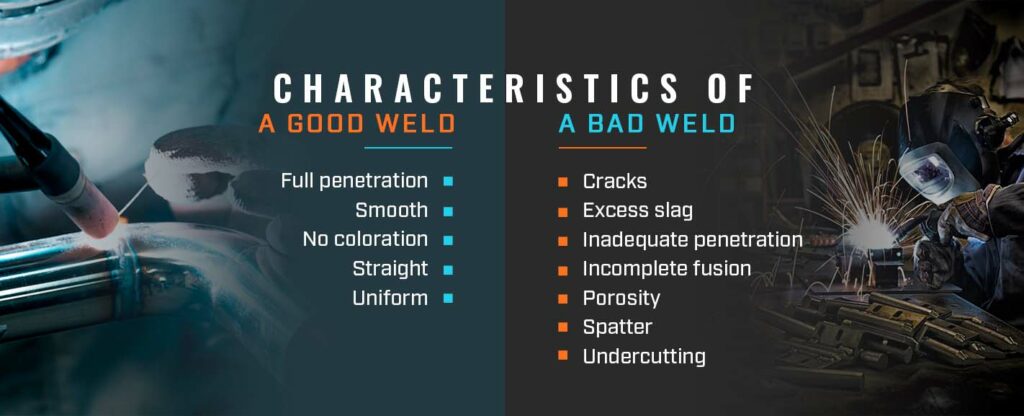
As a welding professional, it is essential to understand the characteristics of both a good and bad weld.
Producing a high-quality weld that offers strength and stability should be the top priority for every welder. However, many different problems and obstacles can arise during the welding process. We are breaking down the ways you can differentiate a good weld from a bad one and some of the typical causes for common defects.
Explore the difference between a good weld and a bad weld and what to look for when utilizing different welding techniques.
You can determine the quality of the weld through visual inspections and other testing methods. The primary characteristics to explore when evaluating a weld include:
There are various methods to inspect and ensure a weld is done effectively, such as:
One of the first things you will notice with a good weld is its consistency. The work does not have to look perfect, but it should have a uniform surface finish without any obvious signs of defects. The following are the key characteristics of a high-quality weld:
A good weld will have these features and provide a cohesive bond that is strong and solid. Thanks to its consistency, the weld will often look more polished and subtle. It does not need to look invisible, it just needs uniformity and smoothness. Welders can achieve this with the proper technique and amount of both heat and filler material.

A bad weld will often be inconsistent and have visible defects. Some of the common characteristics present in a poor weld include the following:
Discoloration or burn marks from the torch along the weld may also indicate a poor welding job.
Different welding methods have different indicators of a good or bad weld. Explore these popular techniques and what to look for with each to determine the quality of the weld:
Stick welding is also called shielded metal arc welding. It is the most popular welding technique and one of the easiest to learn. Distinguishing whether a weld with this method is good or bad is also straightforward.
A good weld completed with stick welding will be straight and uniform. Its thickness will remain consistent throughout the entire weld, and there will be no spatter or cracks.
Spatter is the most common problem with stick welding and can occur if the welding current is too high.
Learn About Our MIG and TIG Welding Services →
Metal inert gas (MIG) welding is another technique that is generally used for larger materials. This method should produce a weld that looks smooth and features no craters or dips in the weld bead. A good MIG weld will have a flat bead profile with no discoloration on the weld itself.
MIG welding involves a thicker weld that makes it more obvious when there are defects present. The following are a few signs of a bad MIG weld:
Tungsten inert gas (TIG) welding is another common technique. It is slightly more challenging to master than stick and MIG methods, which can make it harder to achieve a good weld.
A quality TIG weld will feature many tiny welds carefully layered upon each other. There should not be any burnout or slag. A good weld with this technique will look satisfying and visually appealing with a distinct pattern.
Erratic beads or inconsistent patterns are telltale signs of a bad TIG weld.
At PBZ Manufacturing, we understand how to establish a manufacturing process that helps you increase efficiency and lower your costs. We are your one-stop shop for metal manufacturing solutions. From engineering to shipping, we have you covered.
We have the precision machinery you need, and our team will work with you every step along the way to ensure you get the end results you want. We also offer contract manufacturing services to help streamline your supply chain and simplify logistics.
Are you interested in getting started? Call 717-584-8767 or get a quote from PBZ Manufacturing today!